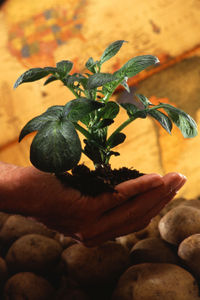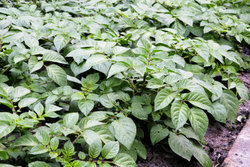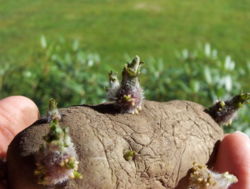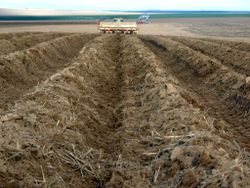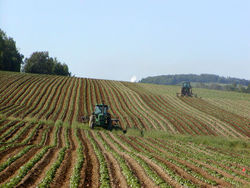Potato
2007 Schools Wikipedia Selection. Related subjects: Food and agriculture
| iPotato | ||||||||||||||||
|---|---|---|---|---|---|---|---|---|---|---|---|---|---|---|---|---|
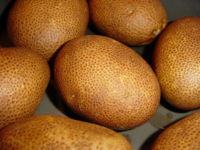 |
||||||||||||||||
| Scientific classification | ||||||||||||||||
|
||||||||||||||||
|
|
||||||||||||||||
| Solanum tuberosum L. |
The potato (Solanum tuberosum) is a perennial plant of the Solanaceae, or nightshade, family, commonly grown for its starchy tuber. Potatoes are the world's most widely grown tuber crop, and the fourth largest crop in terms of fresh produce (after rice, wheat, and maize), but this ranking is inflated due to the high water content of fresh potatoes relative to that of other crops. The potato originated in South America, somewhere in present-day Chile or Peru. Potatoes are important to the culture of the Andes, where farmers grow many different varieties that have a remarkable diversity of colors and shapes. Potatoes spread to the rest of the world after European contact with the Americas in the late 1400s and early 1500s and have since become an important field crop.
Botanical description
Potato plants have a low-growing habit and bear white to purple flowers with yellow stamens.
Potato varieties bear flowers containing asexual parts. Flowers are mostly cross-pollinated by other potato plants, including by insects, but a substantial amount of self-fertilizing occurs. Any potato variety can also be propagated vegetatively by planting pieces of existing tubers, cut to include at least one eye. Some commercial varieties of potatoes do not produce seeds at all (they bear imperfect, single-sex flowers) and are propagated only from tuber pieces. Confusingly, these pieces can bear the name "seed potatoes".
After potato plants flower, some varieties will produce small green fruit that look similar to green cherry-tomatoes. These produce seeds like other fruits. Each of the fruits can contain up to 300 true seeds. One can separate seeds from the fruits by putting them in a blender on a slow speed with some water, then leaving them in water for a day so that the seeds will sink and the rest of the fruit will float. However, some horticulturists sell chimeras made by grafting a tomato plant onto a potato plant, which can produce both edible tomatoes and potatoes.
Production
According to the Food and Agriculture Organization, the worldwide production of potatoes in 2005 was 322 million metric tons (710 billion pounds) which makes it the fifth highest production crop in the world.
Food value
| Potato, raw, with peel Nutritional value per 100 g |
||||||||||||||||||||||||||||||||
|---|---|---|---|---|---|---|---|---|---|---|---|---|---|---|---|---|---|---|---|---|---|---|---|---|---|---|---|---|---|---|---|---|
| Energy 80 kcal 320 kJ | ||||||||||||||||||||||||||||||||
|
||||||||||||||||||||||||||||||||
| Percentages are relative to US recommendations for adults. |
||||||||||||||||||||||||||||||||
Nutritionally, potatoes are best known for their carbohydrate content (approximately 26 grams in a medium potato. Starch is the predominant form of carbohydrate found in potatoes. A small but significant portion of the starch in potatoes is resistant to enzymatic digestion in the stomach and small intestine and, thus, reaches the large intestine essentially intact. This portion of starch, referred to as “resistant starch,” is considered to have similar physiological effects and health benefits of fibre (e.g., provide bulk, offer protection against colon cancer, improve glucose tolerance and insulin sensitivity, lower plasma cholesterol and triglyceride concentrations, increase satiety, and possibly even reduce fat storage) (Cummings et al. 1996; Hylla et al 1998; Raban et al. 1994). The amount of resistant starch found in potatoes is highly dependent upon preparation methods. Cooking and then cooling potatoes significantly increases resistant starch. For example, cooked potato starch contains about 7% resistant starch, which increases to about 13% upon cooling (Englyst et al. 1992).
Potatoes contain a number of important vitamins and minerals. A medium potato (5.3 oz) with the skin provides 27 mg vitamin C (45% of the Daily Value (DV)), 620 mg of potassium (18% of DV), 0.2 mg vitamin B6 (10% of DV) and trace amounts of thiamin, riboflavin, folate, niacin, magnesium, phosphorous, iron, and zinc. Moreover, the fiber content of a potato with skin (2 grams) equals that of many whole grain breads, pastas, and cereals. In addition to vitamins, minerals and fiber, potatoes also contain an assortment of phytochemicals, such as carotenoids and polyphenols. The notion that “all of the potato’s nutrients” are found in the skin is a myth. While the skin does contain approximately half of the total dietary fibre, the majority (> 50%) of the nutrients are found within the potato itself The cooking method used can significantly impact the nutrient availability of the potato.
New and fingerling potatoes offer the advantage that they contain fewer toxic chemicals. Such potatoes offer an excellent source of nutrition. Peeled, long-stored potatoes have less nutritional value, although they still have potassium and vitamin C.
Potatoes are often broadly classified as “high” on the glycemic index (GI) and; thus, are frequently excluded from the diets of individuals trying to follow a “low GI” eating regimen. In fact, the GI of potatoes can vary considerably depending on the type (i.e., red vs. russet vs. white vs. Prince Edward), origin (i.e., where it was grown), preparation methods (i.e., cooking method, whether it is eating hot or cold, whether it is mashed or cubed or consumed whole, etc), and what it is consumed with (i.e., the addition of various high fat or high protein toppings)(Fernandes et al. 2005).
Cooking
General Methods
Potatoes are prepared in many ways: skin-on or peeled, whole or cut up, with seasonings or without. The only requirement involves cooking to break down the starch. Most potato dishes are served hot, but some are first cooked then served cold, notably potato salad and potato chips/crisps.
Common dishes are: mashed potatoes, which are boiled, peeled (sometimes not), and mashed with milk and butter; whole baked potatoes; boiled or steamed potatoes; French-fried potatoes or chips; cut into cubes and roasted; scalloped, diced, or sliced and fried (home fries); grated into small thin strips and fried (hash browns); grated and formed into dumplings, Rösti or potato pancakes. Potatoes, unlike many foods, can also be easily cooked in a microwave oven and still retain nearly all of their nutritional value, provided that they are covered in ventilated plastic wrap to prevent moisture from escaping—this method produces a meal very similar to a baked potato. Potato chunks also commonly appear as a stew ingredient.
Regional dishes
Mashed potatoes form a major component of several traditional dishes from the British Isles such as shepherd's pie, bubble and squeak, champ and the 'mashit tatties' (Scots language) which accompany haggis. They are also often sautéed to accompany a meal.
Potatoes are very popular in continental Europe as well. In Italy, they serve to make a type of pasta called gnocchi. Potatoes form one of the main ingredients in many soups such as the pseudo-French vichyssoise and Albanian potato and cabbage soup.
In the United States, potatoes have become one of the most widely consumed crops, and thus have a variety of preparation methods and condiments. One popular favorite involves a baked potato with cheddar cheese (or sour cream and chives) on top, and in New England "smashed potatoes" (a chunkier variation on mashed potatoes, retaining the peel) have great popularity.
In Scandinavia, especially Denmark, Sweden and Finland, newly harvested, early ripening varieties are considered a special delicacy. Boiled whole and served with dill, these "new potatoes" are traditionally consumed together with pickled Baltic herring.
A traditional Canary Islands dish is Canarian wrinkly potatoes or Papas arragudas.
A traditional Acadian dish from New Brunswick is known as poutine râpée. The Acadian poutine is a ball of grated and mashed potato, salted, sometimes filled with pork in the centre, and boiled. The result is a moist ball about the size of a baseball. It is commonly eaten with salt and pepper or brown sugar. It is believed to have originated from the German Klöße, prepared by early German settlers who lived among the Acadians.
Toxic compounds in potatoes
Potatoes contain glycoalkaloids, toxic compounds, of which the most prevalent are solanine and chaconine. Cooking at high temperatures (over 170 °C or 340 °F) partly destroys these. The concentration of glycoalkaloid in wild potatoes suffices to produce toxic effects in humans. Glycoalkaloids occur in the greatest concentrations just underneath the skin of the tuber, and they increase with age and exposure to light. Glycoalkaloids may cause headaches, diarrhea, cramps and in severe cases coma and death; however, poisoning from potatoes occurs very rarely. Light exposure also causes greening, thus giving a visual clue as to areas of the tuber that may have become more toxic; however, this does not provide a definitive guide, as greening and glycoalkaloid accumulation can occur independently of each other. Some varieties of potato contain greater glycoalkaloid concentrations than others; breeders developing new varieties test for this, and sometimes have to discard an otherwise promising cultivar.
Breeders try to keep solanine levels below 0.2 mg/g (200 ppmw). However, when even these commercial varieties turn green, they can approach concentrations of solanine of 1 mg/g (1000 ppmw). Some studies suggest that 200 mg of solanine can constitute a dangerous dose. This dose would require eating 1 average-sized spoiled potato or 4 to 9 good potatoes (over 3 pounds or 1.4 kg) at one time. The National Toxicology Program suggests that the average American consumes at most 12.5 mg/person/day of solanine from potatoes. Dr. Douglas L. Holt, the State Extension Specialist for Food Safety at the University of Missouri - Columbia, notes that no reported cases of potato-source solanine poisoning have occurred in the U.S. in the last 50 years and most cases involved eating green potatoes or drinking potato-leaf tea.
Solanine is also found in other plants, in particular the deadly nightshade. This poison affects the nervous system causing weakness and confusion. See Solanine for more information.
See also List of poisonous plants
Cultivation
Potatoes are generally grown from the eyes of another potato and not from seed. Home gardeners often plant a piece of potato with two or three eyes in a hill of mounded soil. Commercial growers plant potatoes as a row crop using seed tubers, young plants or microtubers and may mound the entire row.
At harvest time, gardeners generally dig up potatoes with a three-prong "grape" (or "graip") or spading fork, but in larger plots, the plough can serve as the most expeditious implement for unearthing potatoes. Commercial harvesting is typically done with large potato harvesters which scoop up the plant and the surrounding earth. This is transported up an apron chain consisting of steel links several feet wide. This separates some of the dirt. The chain deposits into an area where further separation occurs. Different designs employ different systems at this point. The most complex designs use vine choppers and shakers, along with a blower system or "Flying Willard" to separate the potatoes from the plant. The result is then usually run past workers who continue to sort out plant material, stones, and rotten potatoes before the potatoes are continuously delivered to a wagon or truck. Further inspection and separation occurs when the potatoes are unloaded from the field vehicles and put into storage.
Eliminating all root-weeds is desirable in potato cultivation. Three plowings, with necessary harrowings and rollings, are desirable if they can be accomplished before the appropriate planting time.
It is important to harvest potatoes before heavy frosts begin, since field frost damages potatoes in the ground, and even cold weather makes potatoes more susceptible to bruising and possibly later rotting which can quickly ruin a large stored crop.
Seed potato crops are 'rogued' in some countries to eliminate diseased plants or those of a different variety from the seed crop.
Pests
A major pest of potato plants is the Colorado potato beetle.
The potato root nematode is a microscopic worm that thrives on the roots, thus causing the potato plants to wilt. Since its eggs can survive in the soil for several years, crop rotation is recommended.
New potatoes
Potatoes are generally cured after harvest to thicken the skin. Prior to curing, the skin is very thin and delicate and the potatoes are known as "New Potatoes" and are particularly flavorful. New potatoes are often harvested by the home gardener by "grabbling", i.e. pulling out the young tubers by hand while leaving the plant in place. In markets one sometimes finds thin-skinned varieties sold as new potatoes.
Storage
Storage facilities need to be carefully designed to keep the potatoes alive and slow the natural process of decomposition, which involves the breakdown of starch. It is crucial that the storage area is dark, well ventilated and ideally maintained at a temperature of about 4 degrees Celsius. Potatoes must not be kept in a refrigerator. Cold temperatures convert potatoes' starch into sugar, which alters their taste. Under optimum conditions, potatoes can be stored for up to six months, but several weeks is the normal maximum.
